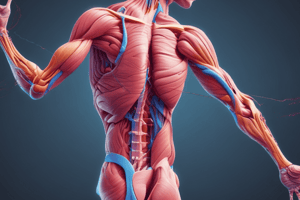Podcast
Questions and Answers
Which type of muscle is specifically found in the heart?
Which type of muscle is specifically found in the heart?
- Cardiac muscle (correct)
- Striated muscle
- Skeletal muscle
- Smooth muscle
Which muscle group is responsible for extending the elbow?
Which muscle group is responsible for extending the elbow?
- Biceps brachii
- Brachialis
- Deltoid
- Triceps brachii (correct)
Which of the following muscles does NOT adduct the thigh?
Which of the following muscles does NOT adduct the thigh?
- Adductor magnus
- Rectus femoris (correct)
- Gluteus maximus
- Adductor longus
What defines a triad in the context of a sarcomere?
What defines a triad in the context of a sarcomere?
Which region of the sarcomere does NOT change in length during muscle contraction?
Which region of the sarcomere does NOT change in length during muscle contraction?
What is the function of the buccinator muscle?
What is the function of the buccinator muscle?
Which of the following muscles is classified as smooth muscle?
Which of the following muscles is classified as smooth muscle?
Which type of muscle has intercalated discs?
Which type of muscle has intercalated discs?
What is the role of acetylcholine in muscle contraction?
What is the role of acetylcholine in muscle contraction?
Which muscle is responsible for dorsiflexion of the foot?
Which muscle is responsible for dorsiflexion of the foot?
In skeletal muscle fibers, where are thick and thin myofilaments found together?
In skeletal muscle fibers, where are thick and thin myofilaments found together?
Which muscle is responsible for raising the eyebrows?
Which muscle is responsible for raising the eyebrows?
What are the three layers of muscles in the lateral abdominal wall, from superficial to deep?
What are the three layers of muscles in the lateral abdominal wall, from superficial to deep?
Flashcards are hidden until you start studying
Study Notes
Muscle Anatomy and Function
- Skeletal muscle is under voluntary control, attached to bone, skin, cartilage, fascia, or a raphe.
- Cardiac muscle is involuntary, striated, and found only in the heart.
- Smooth muscle is involuntary, non-striated, and found in the walls of hollow organs and large vessels.
- Muscle fascicle is a bundle of muscle cells.
Muscle Contraction
- Sarcoplasmic reticulum (SR) stores calcium ions.
- Acetylcholine initiates an impulse in the muscle fiber.
- Triad is the structure formed by a T tubule and two adjacent terminal cisterns.
- A band is where thin and thick myofilaments overlap.
- H band is the zone where only thick filaments are present.
- I band is the zone where only thin filaments are present.
Muscle Movements
- Dorsiflexion is the elevation of the foot.
- Plantar flexion is the lowering of the foot.
- Flexion of the knee is performed by the hamstring group.
- Extension of the elbow is performed by the triceps brachii.
- Antagonists are muscles that perform opposing actions.
- Prime movers are muscles that generate the most force for a particular movement.
Specific Muscles
- Digastric muscle opens the mouth.
- Buccinator muscle is used for sucking and whistling.
- Tibialis anterior dorsiflexes the foot.
- Gastrocnemius and soleus plantar flex the foot.
- Quadriceps femoris group extends the knee, and includes the rectus femoris.
- Hamstring group flexes the knee, and includes the biceps femoris.
- Masseter and temporalis are prime movers for chewing.
- Hyoglossus muscle depresses the tongue.
- Platysma muscle forms the anterior surface of the neck.
- Orbicularis oculi is a muscle surrounding the eye.
- Rotator cuff is a group of muscles stabilizing the shoulder joint; the teres major is not part of this group.
- Medial rectus muscle rotates the eyeball medially.
- External oblique, internal oblique, and transversus abdominis are the muscles of the lateral abdominal wall, arranged from superficial to deep.
- Frontal belly of the occipitofrontalis muscle raises the eyebrow.
Studying That Suits You
Use AI to generate personalized quizzes and flashcards to suit your learning preferences.




